Numerical Simulation of an Air-Core Vortex and Its Suppression at an Intake Using OpenFOAM
Abstract
1. Introduction
Vortex Models
2. Materials and Methods
2.1. Experimental Set-Up
2.2. Numerical Approach
2.2.1. Governing Equations
2.2.2. OpenFOAM Application and Procedures
3. Results and Discussions
3.1. Visualisation of the Air-Core Vortex
3.2. Assessment of Different Turbulence Models
3.3. Suppression of Air Entrainment Using an Anti-Vortex Device
4. Conclusions
- The new approach of using the LTSInterFoam solver, as highlighted in this study, proved to be a reliable means for the steady-state simulation of a free surface vortex at an intake. The LTSInterFoam solver, until now, has been associated with hydrodynamic studies involving ships. However, being a steady state solver, it is unable to account for the transient process of evolution of a free surface vortex.
- The SST model provided the best results compared to the other turbulence models.
- The approach highlighted in this study can be used to investigate the effectiveness of an anti-vortex device in suppressing the formation of an air-core vortex.
Author Contributions
Funding
Acknowledgments
Conflicts of Interest
References
- Guyot, G.; Pittion-Rossillon, A.; Archer, A. A free surface vortex modelling with a 3D CFD comparison between an experimental case and a numerical one. In Proceedings of the 3rd IAHR Europe Congress, Porto, Portugal, 14–16 April 2014. [Google Scholar]
- Yildirim, N. Critical submergence for a rectangular Intake. J. Eng. Mech. 2004, 130, 1195–1210. [Google Scholar] [CrossRef]
- Farell, C.; Cuomo, A.R. Characteristics and modeling of intake vortices. J. Eng. Mech. 1984, 110, 723–742. [Google Scholar] [CrossRef]
- Knauss, J. Swirling flow problems at intakes. In IAHR Hydraulic Structures Design Manual 1; Balkema: Leiden, The Netherlands, 1987; pp. 13–38. [Google Scholar]
- Rindels, A.J.; Gulliver, J.S. An Experimental Study of Critical Submergence to Avoid Free-Surface Vortices at Vertical Intakes; The University of Minnesota: Minneapolis, MN, USA, 1983. [Google Scholar]
- Mulligan, S.; Casserly, J.; Sherlock, R. Effects of geometry on strong free-surface vortices in subcritical approach flows. J. Hydraul. Eng. 2016, 142, 1–12. [Google Scholar] [CrossRef]
- Mulligan, S.; Casserly, J.; Sherlock, R. Experimental and numerical modelling of free-surface turbulent flows in full air-core water vortices. In Advances in Hydroinformatics; Gourbesville, P., Cunge, J.A., Caignaert, G., Eds.; Springer WaterSpringer: Singapore, 2016; pp. 549–569. ISBN 9789812876140. [Google Scholar]
- Shabara, H.M.; Yaakob, O.B.; Ahmed, Y.M.; Elbatran, A.H. CFD simulation of water gravitation vortex pool flow for mini hydropower plants. J. Teknol. 2015, 74, 77–81. [Google Scholar] [CrossRef]
- Levi, E. A fluidic vortex device for water treatment processes. J. Hydraul. Res. 1983, 21, 17–31. [Google Scholar] [CrossRef]
- Andoh, R.; Osei, K.; Fink, J.; Faram, M. Novel drop shaft system for conveying and controlling flows from high level sewers into deep tunnels. In Proceedings of the World Environmental and Water Resources Congress, Honolulu, HI, USA, 12–16 May 2008; pp. 1–9. [Google Scholar]
- Huang, T.-H.; Jan, C.-D.; Hsu, Y.-C. Numerical simulations of water surface profiles and vortex structure in a vortex settling basin by using FLOW-3D. J. Mar. Sci. Technol. 2017, 25, 531–542. [Google Scholar]
- Vatistas, G.H.; Lin, S.; Kwock, C.K. Theoretical and experimental studies on vortex chamber flows. AIAA J. 1986, 24, 635–642. [Google Scholar] [CrossRef]
- Rabe, B.K.; Najafabadi, S.H.G.; Sarkardeh, H. Numerical simulation of anti-vortex devices at water intakes. Proc. Inst. Civ. Eng.-Water Manag. 2016, 171, 18–29. [Google Scholar] [CrossRef]
- Rankine, W.J.M. Manual of Applied Mechanics; C. Griffen Co.: London, UK, 1858. [Google Scholar]
- Scully, M. Computation of Helicopter Rotor Wake Geometry and Its Influence on Rotor Harmonic Airloads; Massachusetts Institute of Technology: Cambridge, MA, USA, 1975. [Google Scholar]
- Burgers, J.M. A mathematical model illustrating the theory of turbulence. Adv. Appl. Mech. 1948, 1, 171–199. [Google Scholar]
- Vatistas, G.H.; Kozel, V.; Mih, W.C. A simpler model for concentrated vortices. Exp. Fluids 1991, 11, 73–76. [Google Scholar] [CrossRef]
- Hite, J.E.; Mih, W.C. Velocity of air-core vortices at hydraulic intakes. J. Hydraul. Eng. 1994, 120, 284–297. [Google Scholar] [CrossRef]
- Wang, Y.; Jiang, C.; Liang, D. Comparison between empirical formulae of intake vortices. J. Hydraul. Res. 2011, 49, 113–116. [Google Scholar] [CrossRef]
- Sun, H.; Liu, Y. Theoretical and experimental study on the vortex at hydraulic intakes. J. Hydraul. Res. 2015, 53, 787–796. [Google Scholar] [CrossRef]
- Gordon, J.L. Vortices at Intake. Water Power 1970, 22, 137–138. [Google Scholar]
- Reddy, Y.R.; Pickford, J.A. Vortices at Intakes in Conventional Sump. Water Power 1972, 24, 108–109. [Google Scholar]
- Prosser, M.J. The Hydraulic Design of Pump Sumps and Intake; British Hydromechanics Research Association: Cranfield, UK, 1977. [Google Scholar]
- Nakayama, A.; Hisasue, N. Large eddy simulation of vortex flow in intake channel of hydropower facility. J. Hydraul. Res. 2010, 48, 415–427. [Google Scholar] [CrossRef]
- Chen, Y.; Wu, C.; Wang, B.; Du, M. Three-dimensional Numerical Simulation of Vertical Vortex at Hydraulic Intake. Procedia Eng. 2012, 28, 55–60. [Google Scholar] [CrossRef]
- Suerich-Gulick, F.; Gaskin, S.; Villeneuve, M.; Holder, G.; Parkinson, E. Experimental and numerical analysis of free surface vortices at a hydropower intake. In Proceedings of the 7th International Conference on Hydroscience and Engineering, Philadelphia, PA, USA, 10–13 September 2006; pp. 1–11. [Google Scholar]
- Ahn, S.; Xiao, Y.; Wang, Z.; Zhou, X.; Luo, Y. Numerical prediction on the effect of free surface vortex on intake flow characteristics for tidal power station. Renew. Energy 2017, 101, 617–628. [Google Scholar] [CrossRef]
- Sarkardeh, H. Numerical calculation of air entrainment rates due to intake vortices. Meccanica 2017, 52, 3629–3643. [Google Scholar] [CrossRef]
- Chen, Y.; Wu, C.; Ye, M.; Ju, X. Hydraulic characteristics of vertical vortex at hydraulic intakes. J. Hydrodyn. Ser. B 2007, 19, 143–149. [Google Scholar] [CrossRef]
- Kabiri-Samani, A.R.; Borghei, S.M. Effects of anti-vortex plates on air entrainment by free vortex. Sci. Iran. 2013, 20, 251–258. [Google Scholar]
- Amiri, S.M.; Roshan, R.; Zarrati, A.R.; Sarkardeh, H. Surface vortex prevention at power intakes by horizontal plates. Proc. Inst. Civ. Eng. Manag. 2011, 164, 193–200. [Google Scholar] [CrossRef]
- Taghvaei, S.M.; Roshan, R.; Safavi, K.; Sarkardeh, H. Anti-vortex structures at hydropower dams. Int. J. Phys. Sci. 2012, 7, 5069–5077. [Google Scholar] [CrossRef]
- Monshizadeh, M.; Tahershamsi, A.; Rahimzadeh, H. Vortex dissipation using a hydraulic-based anti-vortex device at intakes. Int. J. Civ. Eng. 2017, 16, 1137–1144. [Google Scholar] [CrossRef]
- Monshizadeh, M.; Tahershamsi, A.; Rahimzadeh, H.; Sarkardeh, H. Comparison between hydraulic and structural based anti-vortex methods at intakes. Eur. Phys. J. Plus 2017, 132, 1–11. [Google Scholar] [CrossRef]
- Tahershamsi, A.; Rahimzadeh, H.; Monshizadeh, M.; Sarkardeh, H. A new approach on anti-vortex devices at water intakes including a submerged water jet. Eur. Phys. J. Plus 2018, 133, 1–11. [Google Scholar] [CrossRef]
- Borghei, S.M.; Kabiri-Samani, A.R. Effect of anti-vortex plates on critical submergence at a vertical intake. Sci. Iran. 2010, 17, 89–95. [Google Scholar]
- Trivellato, F. Anti-vortex devices: Laser measurements of the flow and functioning. Opt. Lasers Eng. 2010, 48, 589–599. [Google Scholar] [CrossRef]
- Mih, W.C. Discussion of Analysis of fine particle concentrations in a combined vortex. J. Hydraul. Res. 1990, 28, 392–395. [Google Scholar] [CrossRef]
- Sarkardeh, H.; Zarrati, A.R.; Jabbari, E.; Tavakkol, S. Velocity field in a reservoir in the presence of an air-core vortex. Proc. Inst. Civ. Eng. Manag. 2014, 167, 356–364. [Google Scholar] [CrossRef]
- Jones, W.P.; Launder, B.E. The prediction of laminarization with a two-equation model of turbulence. Int. J. Heat Mass Transf. 1972, 15, 301–314. [Google Scholar] [CrossRef]
- Yakhot, V.; Orszag, S.A. Renormalization group analysis of turbulence. I. Basic theory. J. Sci. Comput. 1986, 1, 3–51. [Google Scholar] [CrossRef]
- Yakhot, V.; Orszag, S.A.; Thangam, S.; Gatski, T.B.; Speziale, C.G. Development of turbulence models for shear flows by a double expansion technique. Phys. Fluids 1992, 4, 1510–1520. [Google Scholar] [CrossRef]
- Andersson, B.; Andersson, R.; Håkansson, L.; Mortensen, M.; Sudiyo, R.; Van Wachem, B. Computational Fluid Dynamics for Engineers; Cambridge University Press: Cambridge, UK, 2011. [Google Scholar]
- Wilcox, D. Reassessment of the scale-determining equation for advanced turbulence models. AIAA J. 1988, 26, 1299–1310. [Google Scholar] [CrossRef]
- Wilcox, D.C. Turbulence Modeling for CFD, 2nd ed.; DCW Industries: La Canada, CA, USA, 1998. [Google Scholar]
- Menter, F.R. Review of the shear-stress transport turbulence model experience from an industrial perspective. Int. J. Comput. Fluid Dyn. 2009, 23, 305–316. [Google Scholar] [CrossRef]
- Menter, F.R.; Carregal, F.J.; Esch, T.; Konno, B. The SST turbulence model with improved wall treatment for heat transfer predictions in gas turbines. In Proceedings of the International Gas Turbine Congress, Tokyo, Janpan, 2–7 November 2003. [Google Scholar]
- Robinson, S.K.; Kline, S.J.; Spalart, P.R. A review of quasi-coherent structures in a numerically simulated turbulent boundary layer. NASA Tech. Rep. 1989, TM-10, 1–44. [Google Scholar]
- Robinson, S.K. Coherent Motions in the Turbulent Boundary Layer. Annu. Rev. Fluid Mech. 1991, 23, 601–639. [Google Scholar] [CrossRef]
- Moukalled, F.; Mangani, L.; Darwish, M. The Finite Volume Method in Computational Fluid Dynamics. An Advanced Introduction with OpenFoam® and Matlab®; Thess, A., Moreau, R., Eds.; Springer International Publishing: New York, NY, USA, 2016; ISBN 0926-5112. [Google Scholar]
- Robertson, J.M. Hydrodynamics in Theory and Application; Prentice-Hall Inc.: Englewood Cliffs, NJ, USA, 1965. [Google Scholar]
- Menter, F.R. Zonal two-equation k-ω turbulence model for aerodynamic flows. AIAA Pap. 1993, 1993–2906. [Google Scholar]
- Menter, F.R.; Kuntz, M.; Langtry, R. Ten years of industrial experience with the SST turbulence model. Turbul. Heat Mass Transf. 2003, 4, 625–632. [Google Scholar]
- Menter, F. Two-equation eddy-viscosity turbulence models for engineering applications. AIAA J. 1994, 32, 1598–1605. [Google Scholar] [CrossRef]



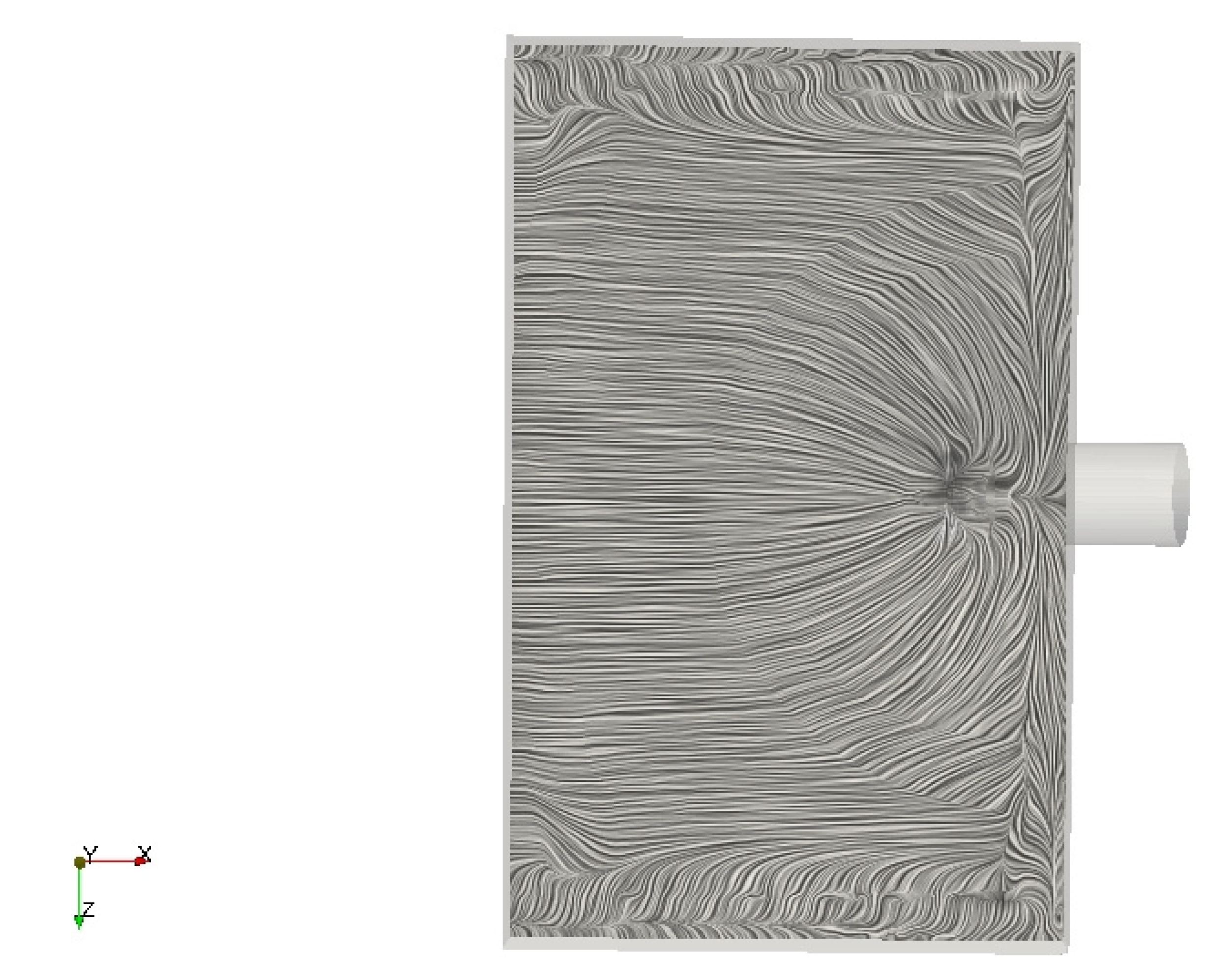

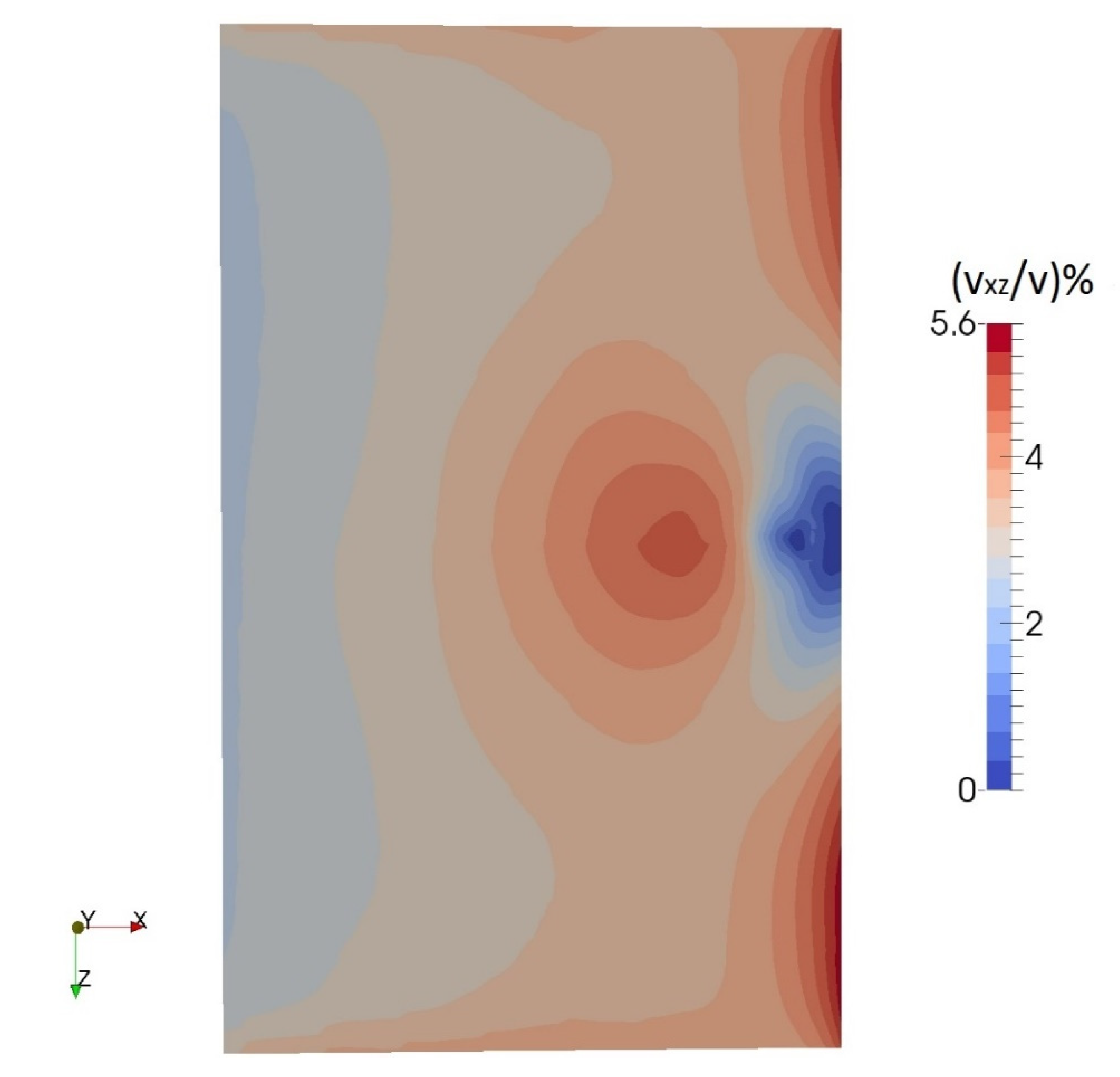
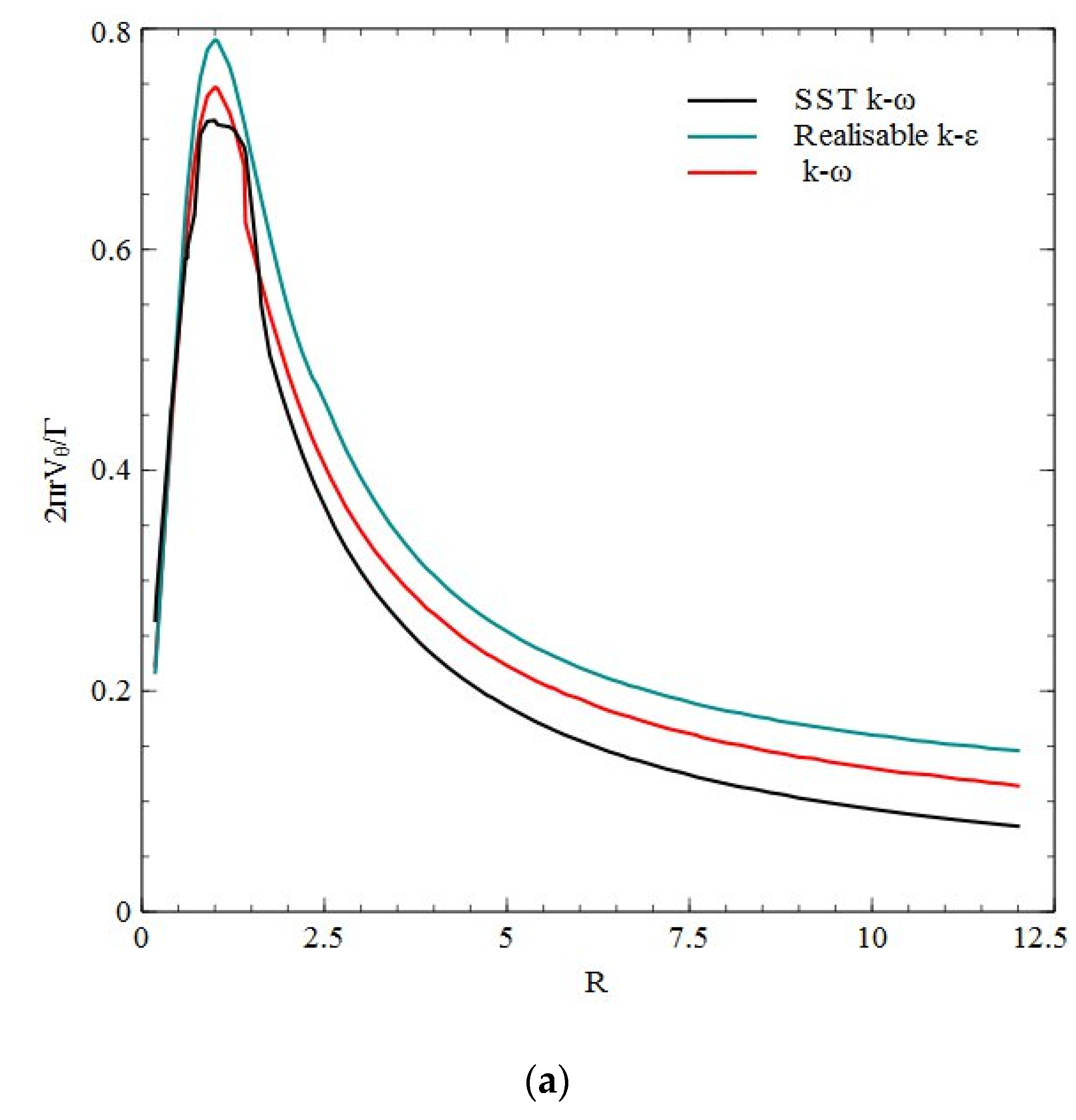
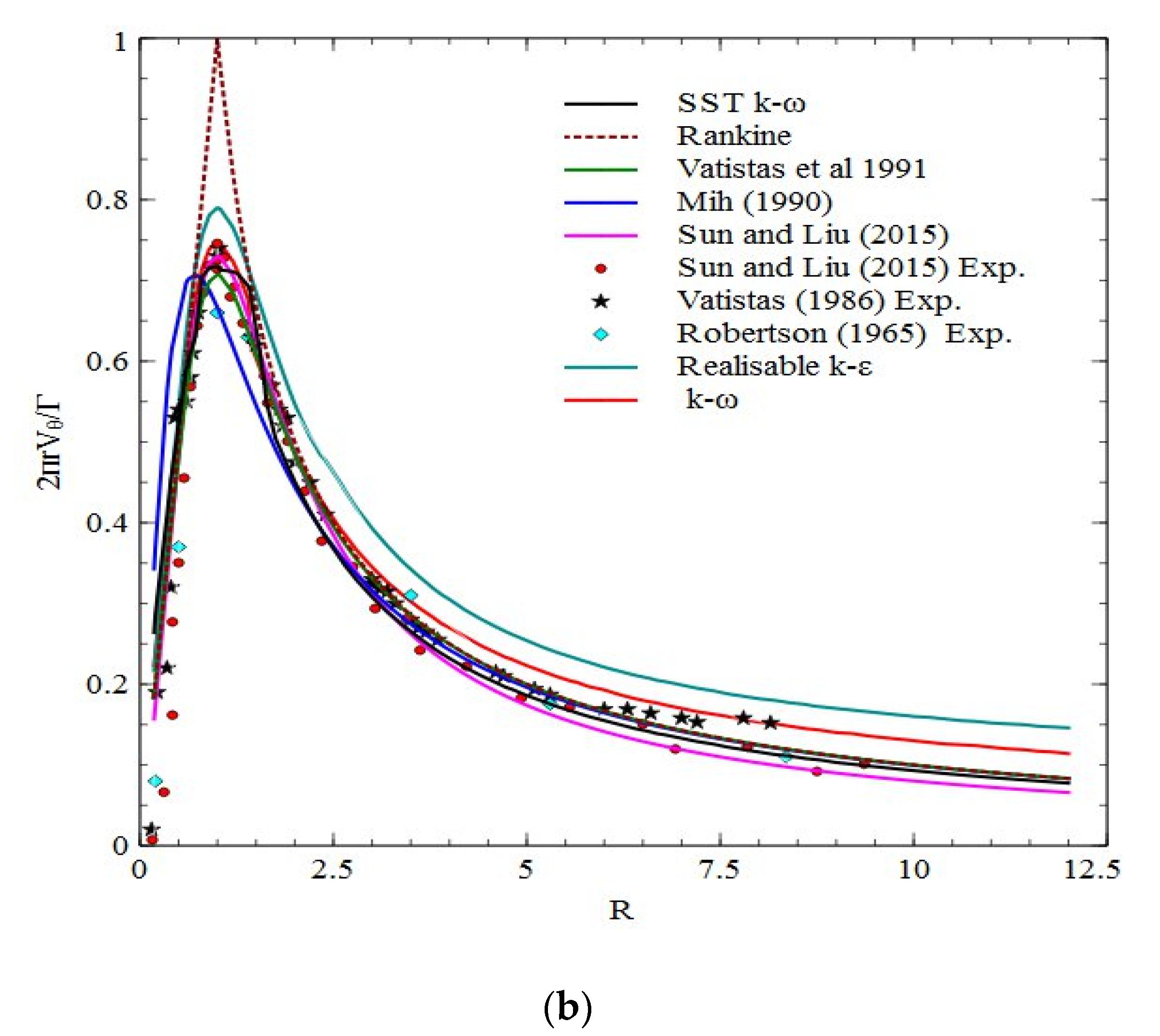
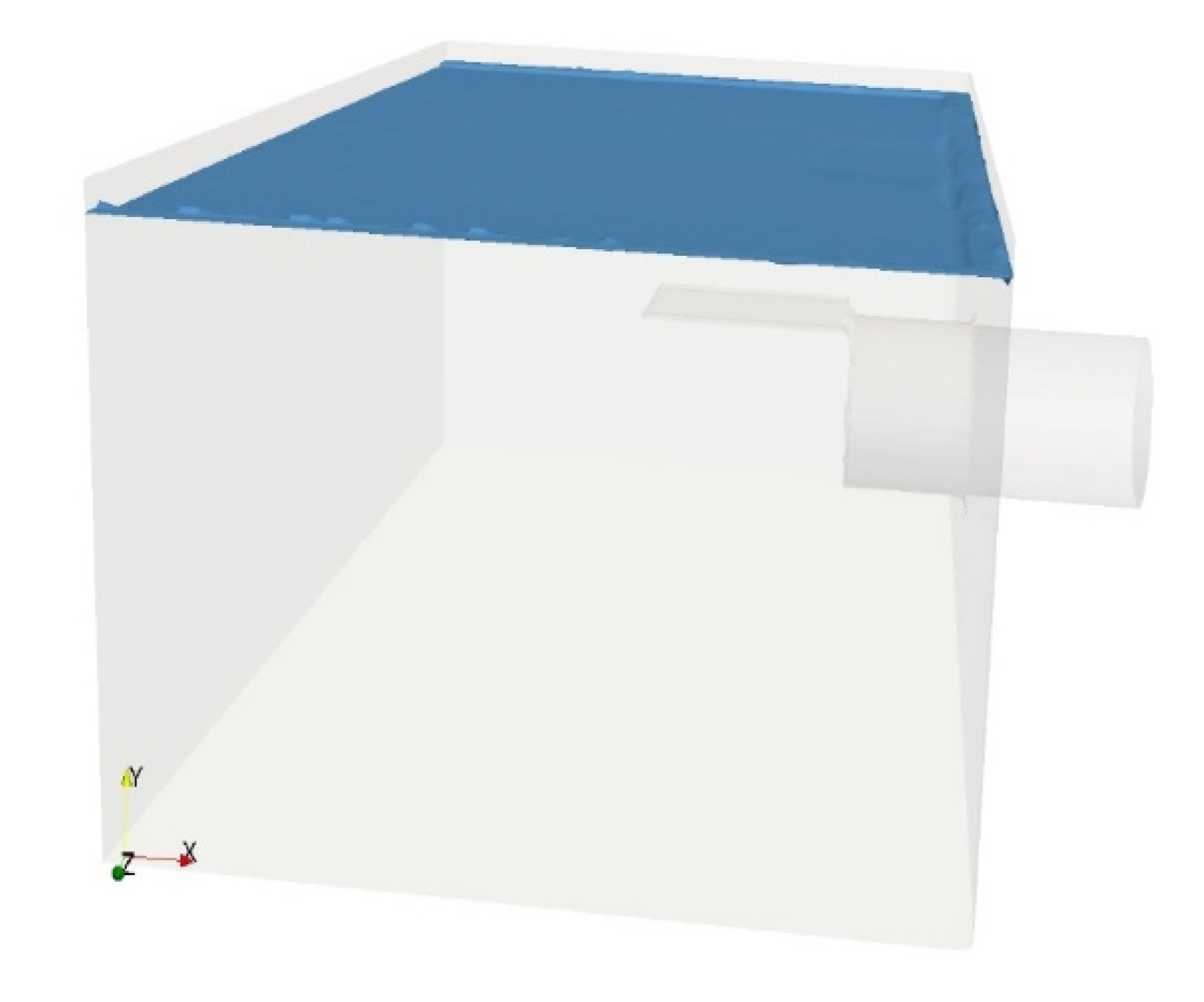
| Variable | Inlet | Outlet | Walls | Atmosphere |
|---|---|---|---|---|
| U | flowRateInletVelocity | flowRateInletVelocity | fixedValue | pressureInlet- OutletVelocity |
| p rgh | fixedFluxPressure | zeroGradient | zeroGradient | totalPressure |
| alpha.water | groovyBC | zeroGradient | zeroGradient | inletOutlet |
| nut | calculated | calculated | nutkRoughWall-Function | zeroGradient |
| k | fixedValue | inletOutlet | kqRWallFunction | inletOutlet |
| omega | fixedValue | inletOutlet | omegaWallFunction | inletOutlet |
Publisher’s Note: MDPI stays neutral with regard to jurisdictional claims in published maps and institutional affiliations. |
© 2020 by the authors. Licensee MDPI, Basel, Switzerland. This article is an open access article distributed under the terms and conditions of the Creative Commons Attribution (CC BY) license (http://creativecommons.org/licenses/by/4.0/).
Share and Cite
Domfeh, M.K.; Gyamfi, S.; Amo-Boateng, M.; Andoh, R.; Ofosu, E.A.; Tabor, G. Numerical Simulation of an Air-Core Vortex and Its Suppression at an Intake Using OpenFOAM. Fluids 2020, 5, 221. https://doi.org/10.3390/fluids5040221
Domfeh MK, Gyamfi S, Amo-Boateng M, Andoh R, Ofosu EA, Tabor G. Numerical Simulation of an Air-Core Vortex and Its Suppression at an Intake Using OpenFOAM. Fluids. 2020; 5(4):221. https://doi.org/10.3390/fluids5040221
Chicago/Turabian StyleDomfeh, Martin Kyereh, Samuel Gyamfi, Mark Amo-Boateng, Robert Andoh, Eric Antwi Ofosu, and Gavin Tabor. 2020. "Numerical Simulation of an Air-Core Vortex and Its Suppression at an Intake Using OpenFOAM" Fluids 5, no. 4: 221. https://doi.org/10.3390/fluids5040221
APA StyleDomfeh, M. K., Gyamfi, S., Amo-Boateng, M., Andoh, R., Ofosu, E. A., & Tabor, G. (2020). Numerical Simulation of an Air-Core Vortex and Its Suppression at an Intake Using OpenFOAM. Fluids, 5(4), 221. https://doi.org/10.3390/fluids5040221






